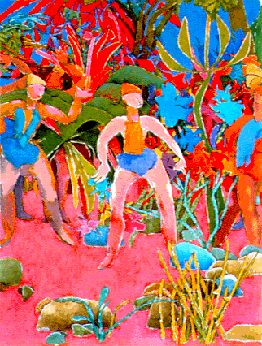|
|
| |
|
Is the computer
being creative? Is A-life creative?
Professor
Harold Cohen, UCSD, spent 30 years of his life working on AARON, an artificial
intelligence/artist.
"Harold
Cohen, former director of the Center for Research in Computing and the
Arts (CRCA), was an English painter with an established international
reputation when he came to UCSD in 1968 for a one-year Visiting Professorship.
His first experience with computing followed almost immediately, and he
never returned to London. Cohen is the author of the celebrated AARON
program, an ongoing research effort in autonomous machine (art making)
intelligence which began when he was a visiting scholar at Stanford University's
Artificial Intelligence Lab in 1973."[5]
"I
wrote it to discover what an independent (machine) intelligence might
do, given some knowledge of the world and some rudimentary physical
capabilities. And, in the process, to have IT teach ME about possibilities
I hadn't imagined. I'd be happier if AARON's work in the future were
LESS like human work, not MORE like human work." [6]
|
| |
|
|
|
|
 |
|
 |
|
-
The first robot in human history to paint original art.
-
AARON mixes its own paints, creates striking artwork and even
washes its own brushes - uses a range of fabric dyes, PROCION.
- Grew
out of investsigations about the nature of "represenation."
Or, how/why we see marks on paper as a "face" or other
real-world objects.
- "AARON
can make paintings of anything it knows about, but it actually
knows about very little -- people, potted plants and trees, simple
objects like boxes and tables, decoration."[6]
- Built
in 'C' but most of AARON's development is in LISP.
-
"AARON has to know what it's doing, and has to spend most
of its time building an internal representation of the developing
drawing so that it can decide what to do next."[6] - No physical
or visual feedback mechanism.
-
"I don't tell it what to do. I tell it what it knows, and
IT decides what to do."[6]
|
| |
|
|
|
| |
|
|
|
| |
|
|
|
| |
|
|
|
|
"How
do I "tell" AARON what it knows? That's a bit hard
to understand if you don't know anything about programming. Some
of AARON's knowledge is what we call "declarative"
knowledge; for example, how long arms and legs are. That
sort of thing is easy to represent. You simply make a list
of parts -- left-upper-arm, torso, etc. -- each of which is
a list of all the points in that part, with the position of the
point in relation to the origin of the part. For example, the
origin of "left-upper-arm" is "left-shoulder",
and "left-elbow" is at some position in relation to
it: so much below, so much to the left, so much in front. AARON
knows that the "left-upper-arm" is tacked on to the
torso, but it can only tack it on in ways that are plausible for
a real body. The program has to know how to go about doing
things, and this "procedural knowledge" is usually represented
in the form of rules. It might look something like this:-
if (left-arm-posture is "hand-on-hip")
(add-upper-arm left -.3 .5 .65)
else
if (left-arm-posture is "arms-folded")
...
and so on. The three numbers here would represent the rotations
around the shoulder on the three axes that would put the arm at
the correct angle before the arm is attached to the torso at the
shoulder. But this is a much-simplified account, because of course
there isn't just one "correct angle," and the way it
chooses one of the three rotations will then influence how the
remaining two can be chosen.
And at a higher level, of course AARON had to decide, using
rules similar in form but different in content, what the "left-arm-posture"
was going to be."[6]
|
| |
|
|
|
|
|
| |
|
|
| |
| "Harold
used computers as a means to test his theories about art. In simple terms,
Harold believed that if his ideas about art were meaningful then his computer
programs and robots would generate meaningful works of art. If his ideas
about art were inconsistent or flawed, then his computer programs and robots
would produce less than acceptable works of art."[4] |
| |
|
|
|
|
| |
| |
|
|



